Overview
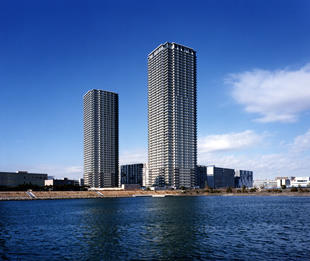 W Comfort Towers (54 and 48 stories)
W Comfort Towers (54 and 48 stories)
High-strength concrete, which is twice to five times as strong as normal, is used as a pillar to support super-high-rise apartment buildings.
This makes it possible to construct apartment houses on the 70th floor over 200m.
We have developed our own concrete technology and applied high-strength concrete exceeding the design strength Fc36MPa to many actual properties. In addition, we will establish a technique that enables us to blend and manufacture ultra-high strength concrete with a design strength Fc200MPa, economically and at high quality, thereby realizing the construction of ultra-high-rise buildings.
TO-HRPC method, which combines precast members, also enables even higher-quality, short-term construction.
In addition, by incorporating organic fibers and carrying out fire resistant coating, the required fire resistance performance is ensured even for high-strength concrete.
This makes it possible to construct apartment houses on the 70th floor over 200m.
We have developed our own concrete technology and applied high-strength concrete exceeding the design strength Fc36MPa to many actual properties. In addition, we will establish a technique that enables us to blend and manufacture ultra-high strength concrete with a design strength Fc200MPa, economically and at high quality, thereby realizing the construction of ultra-high-rise buildings.
TO-HRPC method, which combines precast members, also enables even higher-quality, short-term construction.
In addition, by incorporating organic fibers and carrying out fire resistant coating, the required fire resistance performance is ensured even for high-strength concrete.
Advantages
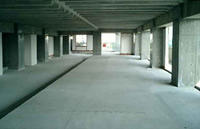 Securing a wide living space
Securing a wide living space
Upgrading
A reinforced concrete structure capable of building super-high-rise buildings (200m high class).Securing a wide living space
By increasing the strength of columns, it is possible to reduce the cross-sectional area of columns and increase the spacing between columns. Secure a large living space and expand the degree of freedom of the flat plan.Ensure high earthquake resistance
High-strength reinforced concrete construction makes it less likely to be shaken by wind or earthquake and ensures high earthquake resistance by combining vibration-damping members.Features
Construction method
Ultra-high strength concrete usually has a feature that it is difficult to construct because of a large amount of cement, but due to its unique proprietary formulation, it has a slump flow of 75cm, enabling concrete to be placed easily with high fluidity.Placing of high-quality concretes ensures the integrity of the building by
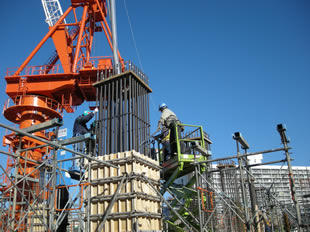
Construction Status Overview of Fc130MPa
Class High Strength Concrete Columns
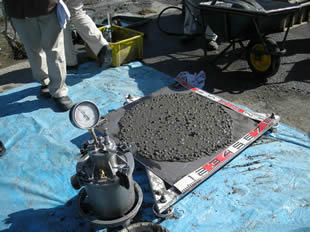
Slump flow with high fluidity
Fire resistance performance
The higher the strength of concrete, the more susceptible it is to damage in the event of fire. Therefore, organic fibers and fire-resistant coatings are applied to ensure the required fire resistance performance. In addition, FIRECC method can also reduce repairs after fires.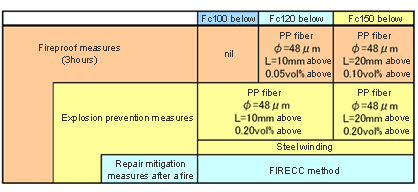
Ensuring fire resistance performance
(FIRECC method: Obtained architectural technology performance evaluation certificate)
Fc200MPa ultra-high strength concrete
We, in collaboration with Harumi Onoda Remicon Co., Ltd., obtained material certification by the Minister of Land, Infrastructure and Transport based on Article 37 of the Building Standards Law for ultra-high strength cast-in-place concrete with a design strength (Fc) 200MPa (certification number: MCON-2585).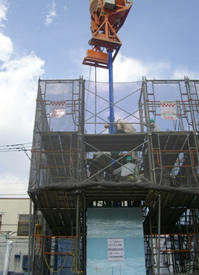
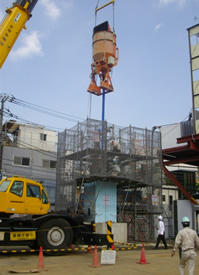
Characteristics of Technologies
- 1 Two types of certifications are obtained: Fc200MPa and Fc180MPa.
- 2 To ensure the stable performance of Fc200MPa, we evaluate them through various tests and use carefully selected materials (bonding materials, fine aggregates, coarse aggregates and chemical admixtures). Especially, two types of silica fume are blended to increase the amount of cement up to 20%.
- 3 Since the water-binder ratio is extremely small (12.5%) and the viscosity becomes large, we have developed a technology to prevent material separation while ensuring workability, thereby achieving a high fluidity of 75 cm slump flow, which is close to the upper limit of concrete fluidity.
- 4 It is manufactured at a ready-mixed concrete plant and transported to the construction site by an agitator vehicle. It is confirmed that the construction can be performed by the usual method of driving it into the formworks using buckets, and that the high quality of concrete can be ensured by curing it for each pole.
- 5 To ensure stable strength, we have established a method of high-temperature curing. Strength is ensured by heat insulation and high-temperature curing at a concrete temperature of 80°C or higher for 72 hours or more, using panel heaters installed in steel formworks, heat insulators, heat reserving material, etc.
- 6 Regarding autogenous shrinkage peculiar to ultra-high strength concrete, we have established a control technology and adopted a technology to prevent cracking due to autogenous shrinkage.
- 7 As a concrete manufacturer, we include quality control including curing and structural strength control (core strength control) in addition to normal unloading quality in the certification, and we consider this the first type of certification in Japan.